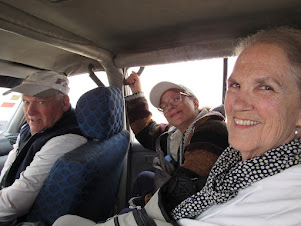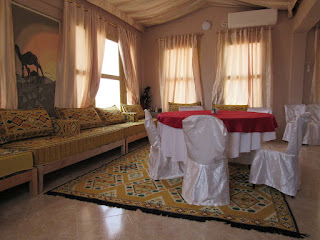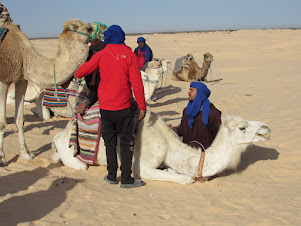





One of the items piled on to the blankets is a traditional Berber/Bedouin cape. Everyone puts it on and poses for photos. We all look pretty funny, but are excited to immerse ourselves in the culture.

Just before 5:30 p.m. we walk to the dune that has the best sightings of the sunset that is due at 5:45. The camp has provided us with benches. Some parts of the dune are especially sandy and I fell. Fortunately, two men by my side helped me up. Otherwise, the ground is fairly stable. The way down the dunes was much easier.

It's a cloudy sky, but a thin layer of light peeks through while up above a
blue sky stands guard with streaks of cloud. The opening to sighting the sun
increases and those people with iPhones get some fantastic photos.



Campfire




Kneading the dough and placing it onto the hot coals.

When the bread is finished, it is taken off the coals and tapped on its side and then wiped of its ashes. Then it is broken into pieces and placed in a basket.
While we waited for the bread to bake, the men brought out drums and sang some traditional songs. They invited us to dance around the fire and we obliged them. Such great and memorable fun!
 Just before we headed to the dining room, the men uncovered two metal covers where the meat and vegetables had been cooking in clay pots in the ground. It turned out to be camel meat with carrots and potatoes in a delicious sauce of rosemary. We also had lentil soup as an entrée and fruit (dates, oranges, bananas) for desert.
Just before we headed to the dining room, the men uncovered two metal covers where the meat and vegetables had been cooking in clay pots in the ground. It turned out to be camel meat with carrots and potatoes in a delicious sauce of rosemary. We also had lentil soup as an entrée and fruit (dates, oranges, bananas) for desert.
Before this delicious dinner was over, we were given hot water bottles. Anas suggested we put them either between our legs or under one arm for the greatest warmth. He showed us a film before we turned in.
It had been a long day, but I am fulfilled with wonder and delight. I congratulate myself on making the decision to come to Tunisia. It is interesting. The group is congenial. Anas, our guide, is knowledgeable and fun; he's teaching us Arabic. And the sights are different from anything I've ever seen before--even in Morocco. I realize that the Arab culture has been propagandized into something aggressive and even evil. That's not true at all! It is authentic, intelligent, sophisticated, and adaptable to its environment. The art is beautiful and colorful and now I understand why it captivated Delacroix, the 19th century French artist. It captivate me!
Of course, we are not living under harsh conditions, but we are seeing a culture opening up itself to us who are more or less ignorant of its virtues, values, qualities, practices, and traditions. While Islam is part of the culture, it doesn't dominate it, at least in Tunisia. It is blended with the realities of geography and history. I really like North Africa and am charmed by it. It's more than sand, oil, dates, and terrorism. I'm so sick of these characterizations that my own culture has promoted. Perhaps I'm further breaking away from a political point of view and becoming more endowed with the global perspective I have sought for the past 40 years since the Kellogg fellowship (1984-87). That is an accomplishment!
I went to bed at 9 p.m. During the night I can hear nothing except sand blowing against the tent. Very little of it. It's dark but I've positioned my flashlight so I can get to it when I need to get up.
Sunrise in the desert

It's time for a camel
Anas, our guide showed us how to be when the camel stood up: straight arms and hold on tight. In this way we wouldn't fall off. The camel rises in its way such that its rider is thrust is a sharp backward and forward motion.
Each camel is led by a trainer/owner who guides two camels tied together by a rope. He then leads one as the other follows closely behind and to the side. My camel's name was Ali while his "partner" was Habibi.
My white steed, Ali, was beautiful. (White camels are highly prized.) He was quite cooperative with his trainer and very tolerant of me. If we approached a dune a little higher than usual, the trainer would warn me to hold on and brace myself. A minor tidbit on camel riding: there are no stirrups on the saddle.


Habibi liked to get close to my side and wipe his nose on my pants. I petted him a bit but tried not to irk him lest he spit on me. Camels can be grouchy.
The trainers were quite willing to take photos with our camels. Here are some good ones of me and Ali. The one with my arms spread is a typical camel-riding pose that is akin to raising up your arms on a roller-coaster. Fortunately, my beast was stationary. When we were walking, I gripped the handles with all my might.

Our group rides the sands of the Sahara like Lawrence of Arabia.
We rode the camels for about 40 minutes. Our jeeps were waiting for us at the end point to take us back to the hotel where we met our bus and took a much-needed bathroom break.
The desert experience was my all-time favorite of the entire trip.

More on Douz
Besides being the Gateway to the Sahara, Douz has also been called the "ultimate palm oasis", because its over 500,000 palm trees produce the "diglat noor" dates. In previous times it was an important stop on the trans-Saharan caravan routes. Today, it is a destination for tourists interested in seeing the desert and a starting point for desert treks like our group that went to a camp for a day. Numerous hotels have also been built here to accommodate the tourists.
People live a sedentary life here because of the climate. Most activities take place after sundown because
of the extreme heat.
Most of the inhabitants of Douz descended from four Arab tribes that left the Arabian peninsula in the 8th century and established the nomadic culture of the Mrazig people. They first went to Egypt and Libya before settling in Tunisia in the 13th century.
Douz is also famous for its annual International Festival of the Sahara, a four-day celebration of traditional desert culture. The festival, usually held in November or December, features traditional music and dancing, hunting, poetry readings, camel wrestling, and racing of horses and salugis (a children's game of keep-away). Douz is also home to the Museum of the Sahara that showcases traditional nomadic desert culture.
Life
in Douz is more Arab than Berber.
The language dialect is even different because it does not have the same
Arab roots. It tends to use few words that mean a lot. Poetry is very
important, which is also a part of the Arab culture.
Camel races where riders put their feet on the camel's neck instead of sitting astride the camel's hump.
Museum of the Sahara


a loom


exhibition hall and dome of the building
A bride is driven from her home to the place of the marriage. She is only able to expose her hand.
Resources
Douz -- https://en.wikipedia.org/wiki/Douz
Museum of the Sahara -- https://www.tripadvisor.com/Attraction_Review-g477972-d1973572-Reviews-Sahara_Museum-Douz_Kebili_Governorate.html#/media/1973572/?albumid=-160&type=ALL_INCLUDING_RESTRICTED&category=-160








































No comments:
Post a Comment